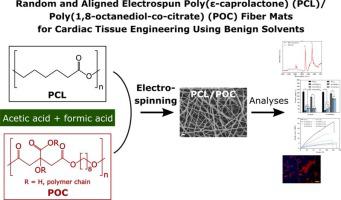European Polymer Journal ( IF 5.8 ) Pub Date : 2021-09-13 , DOI: 10.1016/j.eurpolymj.2021.110772 Lena Vogt 1 , Aldo R. Boccaccini 1

|
Cardiac tissue engineering (CTE) is a rising field of research aiming to provide strategies to repair or regenerate damaged heart tissue after events like myocardial infarction. Here, poly(1,8-octanediol-co-citrate) (POC) has been blended with poly(ε-caprolactone) (PCL) and the blend polymer was electrospun using the benign solvents acetic acid and formic acid to develop cardiac patches for CTE. The fiber mats were thermally crosslinked under mild conditions. Random and aligned PCL/POC fiber mats were investigated with regard to their morphological and physico-chemical properties, their degradation behavior, and their cytocompatibility in vitro. Homogenous and defect-free fibrous structures with average fiber diameters of 0.61 and 1.11 µm were observed for 2:1 and 1:1 ratios of PCL/POC blends. The wettability as well as mechanical properties of the PCL/POC fiber mats were dependent on blend composition, crosslinking treatment, and fiber orientation. While the wettability of the fiber mats was in a suitable range, the mechanical properties even exceeded necessary values for CTE after 14 days of incubation in Dulbecco’s phosphate buffered saline (DPBS). The post-crosslinking of the fiber mats also increased the degradation resistance resulting in less acidic leaching and more stable fibers after 28 days in DPBS. Cytocompatibility tests with C2C12 cells demonstrated an excellent cytocompatibility of PCL/POC blends with a PCL/POC ratio of 2:1. Based on the obtained data, PCL/POC fiber mats made from benign solvents showed promising properties for applications in CTE as cardiac patches and should be subjected to further research to elucidate their in vitro and in vivo potential.
中文翻译:

使用良性溶剂用于心脏组织工程的随机和排列的电纺聚(ε-己内酯)(PCL)/聚(1,8-辛二醇-柠檬酸钴)(POC)纤维垫
心脏组织工程 (CTE) 是一个新兴的研究领域,旨在提供在心肌梗塞等事件后修复或再生受损心脏组织的策略。在这里,聚(1,8-辛二醇-co-柠檬酸盐)(POC)与聚(ε-己内酯)(PCL)共混,共混聚合物使用良性溶剂乙酸和甲酸进行静电纺丝,以开发心脏贴片CTE。纤维垫在温和条件下热交联。研究了随机排列的 PCL/POC 纤维垫的形态和物理化学特性、降解行为和体外细胞相容性。对于 2:1 和 1:1 的 PCL/POC 混合物,观察到平均纤维直径为 0.61 和 1.11 µm 的均匀且无缺陷的纤维结构。PCL/POC 纤维垫的润湿性和机械性能取决于共混物成分、交联处理和纤维取向。虽然纤维垫的润湿性在合适的范围内,但在 Dulbecco 磷酸盐缓冲盐水 (DPBS) 中孵育 14 天后,机械性能甚至超过了 CTE 的必要值。纤维垫的后交联还增加了抗降解性,导致在 DPBS 中 28 天后酸性浸出更少,纤维更稳定。C2C12 细胞的细胞相容性测试表明 PCL/POC 混合物具有出色的细胞相容性,PCL/POC 比例为 2:1。根据获得的数据,











































 京公网安备 11010802027423号
京公网安备 11010802027423号